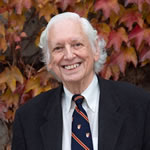
We typically think of communication as a fairly straightforward phenomenon involving speech, gestures, and more recently, electronic devices. But the majority of creatures interact through different means: a dazzling array of chemical signals. This is how insects talk to each other, find food, mate, bind together in communities, even make war. But it's not only bugs that communicate through chemicals—all living organisms, from microorganisms to human beings, do the same. The study of how organisms communicate and interact with their environment is a specialized field called chemical ecology, bridging organic chemistry and biology. Jerrold Meinwald is universally recognized as its founding father, along with Tom Eisner (1929-2011), his longtime biological collaborator. In a career spanning more than half a century, Meinwald defined chemical ecology as a new science, showing how it can help us better understand the behavior of living creatures and leading to important advances in medicine, pharmacology, and agriculture.
Born in New York, Meinwald attended the University of Chicago and obtained his Ph.D. from Harvard, then settled in for a fellowship at Cornell University, where he has spent his entire career. At first, he was known as a creative organic chemist, studying highly strained small molecules, photochemistry, and analytic spectroscopic techniques. He then became intrigued by the chemical defenses of arthropods. Among his early discoveries were lipophilic compounds secreted by some insects that help toxins permeate an attacker's protective cuticle, and the fact that fireflies and some other insects secrete steroids that make them unattractive meals for predators. He investigated the underlying chemical mechanisms that enabled organisms to synthesize these defensive agents, leading to the realization that one species, perhaps a plant, can make a precursor substance later used by another organism, such as an insect—a relationship between two species manifested at a chemical level.
This work led to the forging of a unique collaboration with Eisner, who had been studying many of the same questions from a biological perspective and arrived at Cornell shortly after Meinwald had joined the faculty. They combined forces to elevate the study of chemical signaling into the new discipline of chemical ecology, with Meinwald probing the chemistry and Eisner investigating the biology. They studied and characterized an extensive variety of chemical signaling and defense mechanisms in insects, plants, birds, fish, and mammals. The interactions they explained, from snakes that derive protective steroids for their eggs and hatchlings from toads they consume, to moths that convert a certain alkaloid to attract females which is later passed on as a defensive chemical to their eggs, to fish that secrete substances literally giving them a bad taste to predators, demonstrate the amazing range of remarkable evolutionary adaptations on Earth. The Meinwald/Eisner partnership has opened up brand new vistas in chemistry and biology that are only beginning to be fully explored.
But the work has done even more than give science a deeper insight into the beautiful interconnected web of life on our planet. Meinwald's work in isolating, characterizing, and synthesizing the structure of various compounds used in nature points the way for the development of substances for practical applications: drugs, agricultural chemicals, and other yet unimagined uses. He continues to demonstrate that the natural chemicals that living creatures use to communicate, survive, and thrive have potential and promise waiting to be tapped.
Information as of April 2013

